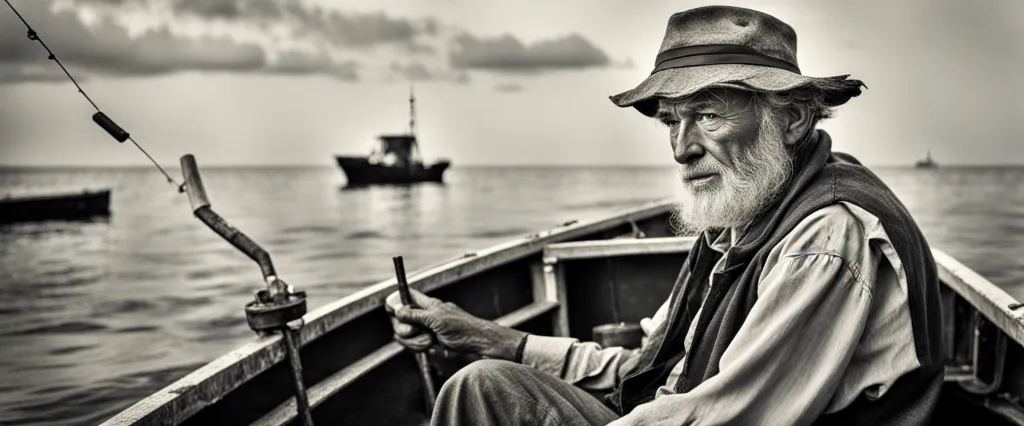
In the realm of literature, countless stories have captivated readers throughout the ages, weaving tales of triumph, tragedy, and everything in between. Among these stories are two remarkable works that have left an indelible mark on the literary landscape: “The Old Man and The Sea” by Ernest Hemingway and “Little Women” by Louisa May Alcott. Though seemingly disparate in subject matter, these two novels share a common thread that draws readers in—the exploration of the human condition and the indomitable spirit within. Through the lens of vastly different settings and narratives, both authors delve into the depths of the human psyche, offering profound insights into the complexities of life, love, and the pursuit of purpose. By undertaking a comparative study of “The Old Man and The Sea” and “Little Women,” we can uncover the underlying themes, character development, and societal contexts that make these works timeless classics. Through this examination, we aim to shed light on the universal themes and profound impact that these novels have had on readers around the world.
Brief Summary of Two Books
The Old Man and The Sea by Ernest Hemingway
“The Old Man and the Sea” by Ernest Hemingway tells the story of an aging Cuban fisherman named Santiago and his relentless struggle against the forces of nature to catch a giant marlin out in the Gulf Stream. Having gone without a catch for weeks, Santiago’s determination and skill are put to the test as he engages in a battle of strength and endurance with the massive fish for three days. Throughout his journey, Santiago faces various obstacles, including hunger, exhaustion, and the fierce predators of the sea. Despite his physical and emotional hardships, Santiago refuses to give up, embodying the theme of resilience and the indomitable human spirit. Finally, he manages to reel in the enormous marlin, only to face another challenge when sharks relentlessly attack and devour his prized catch. The novel explores themes of man’s struggle against nature, the nature of pride, and the importance of perseverance, painting a vivid portrait of a character who refuses to surrender in the face of overwhelming odds.
Little Women by Louisa May Alcott
“Little Women” by Louisa May Alcott is a classic novel published in 1868 that follows the lives of four sisters – Meg, Jo, Beth, and Amy March – as they transition from childhood to adulthood during the Civil War era. The story is set in the fictional town of Concord, Massachusetts and is loosely based on Alcott’s own life.
The book is divided into two parts, each focusing on different stages of the sisters’ lives. The first part introduces the March family and their struggles during the war as their father is serving as a chaplain. While their father is away, the sisters, together with their mother Marmee, learn important life lessons, face challenges, and foster their individual interests and personalities.
The second part of the book explores the sisters’ lives as young women, with each sister pursuing her own goals and aspirations. Meg dreams of a traditional domestic life and eventually marries, Jo strives to become a successful writer and supports her family, Beth battles illness but finds solace in her love for music, and Amy, the youngest, seeks a life of artistic expression and refinement.
Throughout the novel, the sisters navigate themes of love, friendship, family, and societal expectations, demonstrating their determination to lead fulfilling lives on their own terms. Alcott portrays their flaws and strengths, emphasizing the importance of female independence and personal fulfillment during a time when women were often limited by societal norms.
“Little Women” is a heartwarming and sentimental tale that depicts the joys and struggles of sisterhood, as well as the importance of personal growth, female empowerment, and the pursuit of one’s dreams. It continues to captivate readers with its timeless themes and memorable characters.
Comparison between Two Books

Similarities in Life Journey
The Old Man and The Sea by Ernest Hemingway and Little Women by Louisa May Alcott may appear to have different storylines and settings, but both novels share common themes about the journey of life. In both narratives, the characters undergo challenges and personal growth, ultimately realizing the importance of perseverance, resilience, and the pursuit of one’s dreams.
Firstly, both novels emphasize the significance of endurance in the face of adversity. The Old Man and The Sea depicts the struggles of Santiago as he battles with the enormous marlin, enduring physical pain and exhaustion while refusing to give up. Similarly, the March sisters in Little Women encounter numerous hardships, such as poverty, illness, and the absence of their father during the Civil War. However, despite these difficulties, the characters persist and endure, highlighting the idea that facing challenges head-on is vital in the journey of life.
Secondly, both novels explore the theme of resilience. In The Old Man and The Sea, Santiago embodies immense perseverance, remaining steadfast despite the relentless forces of nature and the skepticism of others. Similarly, the March sisters in Little Women exhibit strength and resilience throughout their various trials, such as Jo’s unsuccessful writing career and Beth’s devastating illness. Both stories emphasize the importance of resilience in overcoming obstacles and adapting to life’s setbacks.
Lastly, both books convey the idea of pursuing one’s dreams. In The Old Man and The Sea, Santiago’s ultimate goal is to catch the giant marlin, representing his lifelong dream of proving himself as a capable fisherman. Likewise, the March sisters in Little Women each have distinct aspirations, such as Jo’s desire to become a successful writer or Meg’s wish for a traditional domestic life. Both novels champion the pursuit of one’s dreams, teaching readers the value of setting goals and working hard to achieve them.
In conclusion, The Old Man and The Sea and Little Women share striking similarities regarding the journey of life. Both novels portray characters who face challenges head-on, demonstrate resilience in times of hardship, and emphasize the importance of pursuing one’s dreams. These timeless themes resonate with readers, reminding us of the enduring human spirit and the universal truths that guide our own life journeys.
Divergences in Life Journey
The Old Man and The Sea by Ernest Hemingway and Little Women by Louisa May Alcott are two classic novels that explore different aspects of life journey, providing distinct perspectives and experiences.
In The Old Man and The Sea, Hemingway focuses on the solitary journey of Santiago, an elderly fisherman battling against nature and his own limitations. The story revolves around Santiago’s relentless pursuit of a giant marlin, symbolizing his struggle for personal meaning and significance. Through Santiago’s journey, Hemingway showcases the inherent human desire to conquer challenges, even in the face of adversity. The book delves into themes of perseverance, courage, and the power of the human spirit, highlighting the importance of embracing life’s difficulties as a means of self-discovery.
On the other hand, Little Women by Louisa May Alcott takes a different approach to the life journey. The novel follows the lives of the four March sisters, Meg, Jo, Beth, and Amy, as they navigate the challenges and joys of coming of age in 19th-century New England. Alcott’s story emphasizes personal growth, relationships, and the pursuit of happiness in the context of societal expectations for women during that time. Each sister embarks on her own journey, facing obstacles, disappointment, and triumphs, ultimately learning valuable lessons about love, sisterhood, and the importance of staying true to oneself.
The divergence in the life journeys portrayed in these books lies in their settings, characters, and themes. The Old Man and The Sea focuses on a solitary male character engaged in an epic struggle against nature, representing the internal struggles and quest for personal significance. In contrast, Little Women explores the collective journey of four sisters, highlighting their interconnected lives and the multifaceted aspects of growth, love, and societal pressures faced by women.
Additionally, Hemingway’s book is characterized by its spare, minimalist style, reflective of the protagonist’s simplicity and his isolated existence. In contrast, Alcott’s writing in Little Women is more detailed, emotional, and nuanced, emphasizing the complex web of relationships, emotions, and societal expectations that shape the sisters’ journeys.
In conclusion, while both The Old Man and The Sea and Little Women delve into the theme of life journey, they diverge in their portrayal of protagonists, settings, and writing styles. Hemingway’s novel focuses on an individual’s quest for identity and significance amidst struggle, whereas Alcott’s story explores the collective journeys of women growing up in a specific societal context. Both books offer valuable insights into the human condition, highlighting different aspects of life’s challenges and triumphs.

Conclusion
Both The Old Man and The Sea by Ernest Hemingway and Little Women by Louisa May Alcott are considered classic works of literature and have their own unique appeal. Ultimately, the decision of which book is more worthy of reading depends on individual preferences and interests.
The Old Man and The Sea is a short novella that follows the story of an elderly Cuban fisherman named Santiago, as he battles a giant marlin in the Gulf Stream. This book is renowned for its sparse yet powerful prose, Hemingway’s characteristic writing style. It delves into themes of perseverance, courage, and the human struggle against nature. The Old Man and The Sea is often regarded as one of Hemingway’s finest works and won him the Pulitzer Prize in 1953. It is worth reading for those who appreciate its contemplative nature and deeply symbolic storytelling.
On the other hand, Little Women is a classic novel that tells the story of the March sisters, Meg, Jo, Beth, and Amy, as they navigate life, love, and personal growth during the Civil War era in America. This book explores themes of family, sisterhood, and the societal expectations placed upon women in that era. Little Women is known for its richly developed characters and engaging narrative, capturing the readers’ hearts with its warmth and charm. It has gained a wide and enduring readership since its publication in 1868 and continues to inspire generations of readers, particularly young women. It is worth reading for those who enjoy character-driven stories and coming-of-age tales.
In conclusion, both The Old Man and The Sea and Little Women are highly regarded literary works that offer unique perspectives and themes. The decision of which book is more worthy of reading ultimately depends on one’s personal preferences and interests, be it a contemplative and symbolic story or a heartwarming and character-driven narrative.


